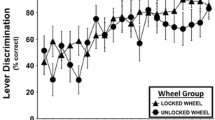Summary
-
1.
Measurements of 24 hr tap water consumption, body weight, “wet dog” shake frequency and free choice drinking (etonitazene, 5 mcg/ml versus distilled water) were made at intervals up to 434 days following abrupt withdrawal of morphine (from a daily maintenance dose level of 200 mg/kg i.p.) in one group of rats (“postaddicts”) and following termination of i.p. injections of saline in a control group of rats (“normals”).
-
2.
During the first five days after termination of injections, signs of primary morphine abstinence were observed in the “postaddict” rats: transient decrease in 24 hr tap water consumption and in body weight, and increase in “wet dog” shake frequency.
-
3.
Secondary morphine-abstinence phenomena, consisting of signicantly greater 24 hr tap water consumption and slightly higher “wet dog” shake frequency (compared with normal rats) were observed in “postaddict” rats over the 7th–23rd post-injection days. Thereafter, these differences persisted, but not at significant levels.
-
4.
In a no-choice test (etonitazene, 5 mcg/ml or water on different occasions) conducted between the 28th and 37th days after termination of injections, “post-addict” rats drank significantly more etonitazene than water, whereas normal rats drank slightly less etonitazene than water.
-
5.
In free-choice drinking tests (etonitazene, 5 mcg/ml versus water) conducted at intervals over a period of 434 days following termination of injections (morphine or saline), no significant differences in mean water consumption between “post-addict” and normal rats were observed. In contrast, “postaddict” rats drank significantly larger mean volumes of the etonitazene solution on every “relapse” test through the 336th and again on the 406th post-withdrawal day (but not on the 372nd or 434th day).
-
6.
It is concluded that in the “postaddict” rat a “need” for an opioid persists for about one year after abrupt withdrawal of morphine, and that this “need” is based on long-term derangement of homeostasis. although the physiological characteristics of such homeostatic derangement differ in the relatively short primary and more protracted secondary abstinence periods.
-
7.
The long persistence of “relapse-tendency” in rats previously made physically dependent on morphine may be based on such long-term derangement of homeostasis coupled, perhaps, with “interoceptive” conditioning generated during daily cycles of primary abstinence from and relief by morphine in the “addiction” period, through which the internal sensorial effects of opioids (morphine while receiving injections; etonitazene imbibed in “relapse” tests) may acquire secondary reinforcing properties.
Similar content being viewed by others
References
Cochin, J., Kornetsky, C.: Development and loss of tolerance to morphine in the rat after single and multiple injections. J. Pharmacol. exp. Ther. 145, 1–10 (1964).
Edwards, A. L.: Statistical methods for the behavioral sciences. New York: Rinehardt and Co. 1954.
Martin, W. R., Wikler, A., Eades, C. G., Pescor, F. T.: Tolerance to and physical dependence on morphine in rats. Psychopharmacologia (Berl.) 4, 247–260 (1963).
Wikler, A., Green, P. C., Smith, H. D., Pescor, F. T.: Use of a benzimidazole derivative with potent morphine-like properties orally as a presumptive reinforcer in conditioning of drug seeking behavior in rats. Fed. Proc. 19, 22 (1960).
—, Martin, W. R., Pescor, F. T., Eades, C. G.: Factors regulating oral consumption of an opioid (etonitazene) by morphine-addicted rats. Psychopharmacologia (Berl.) 5, 55–76 (1963).
—, Pescor, F. T.: Classical conditioning of a morphine abstinence phenomenon, reinforcement of opioid-drinking behavior and “relapse” in morphine-addicted rats. Psychopharmacologia (Berl.) 10, 255–284 (1967).
Author information
Authors and Affiliations
Additional information
This study was supported in part by USPHS grant No. MH 13194 of the National Institute of Mental Health, awarded to the Department of Psychiatry, University of Kentucky College of Medicine.
Formerly Biologist, NIMH Addiction Research Center, Lexington, Kentucky.
Rights and permissions
About this article
Cite this article
Wikler, A., Pescor, F.T. Persistence of “relapse-tendencies” of rats previously made physically dependent on morphine. Psychopharmacologia 16, 375–384 (1970). https://doi.org/10.1007/BF00404848
Received:
Issue Date:
DOI: https://doi.org/10.1007/BF00404848




